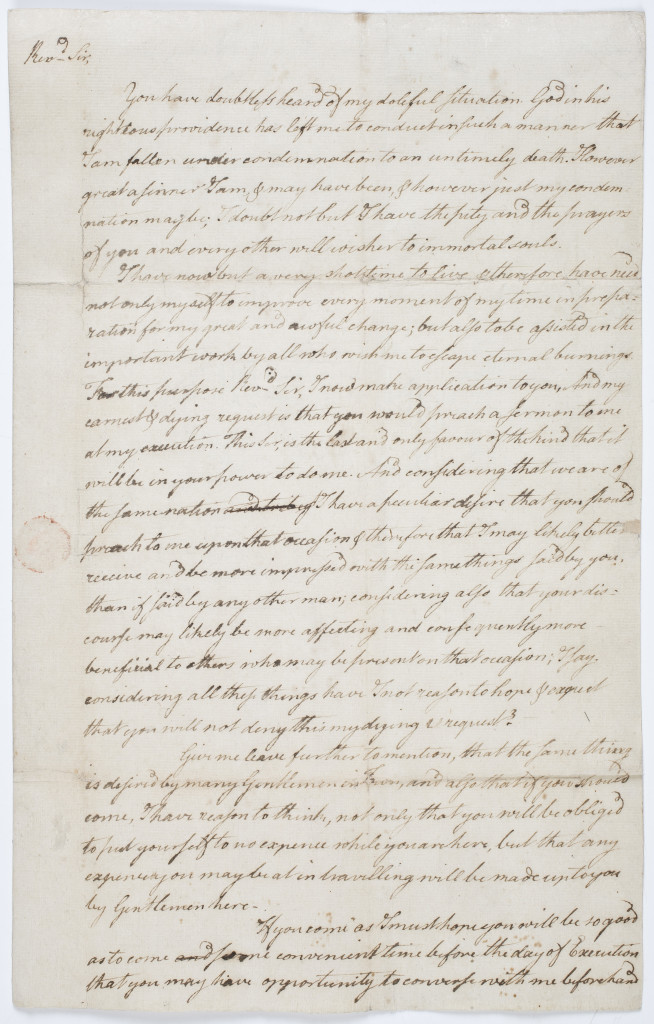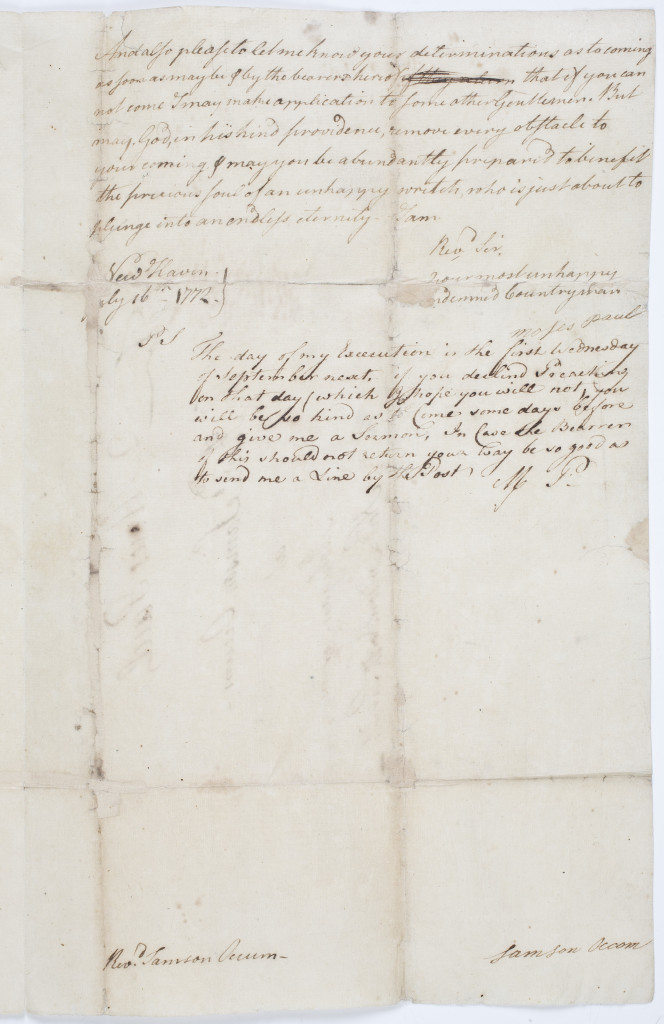Libraries like the American Antiquarian Society exist not just to preserve material, but also to help people find it. Detailed descriptions of items in our catalog records and thoughtfully designed systems of organization ensure that items in our collection can be located. But AAS also relies to a great extent on institutional memory—the knowledge of the collection gained by the members of the staff over years of service. With over four million items in the Society’s collections, however, it’s inevitable that some items that librarians knew about at one point eventually become forgotten, as staff members come and go. This is the story of one particularly exciting item in the AAS collections and how we became reacquainted with it, as well as a set of questions about how it came to be here in the first place.
Samson Occom is now one of the best-known Native American literary figures from early America, and is generally considered to be the first Native American writer to publish a book under his own name. Occom was born in Mohegan country, on what is now the Connecticut coast, in 1723. As a young man he studied English, theology, and Hebrew with Eleazar Wheelock (who would later go on to found Dartmouth College), and would eventually be ordained as a Presbyterian minister in 1759 after already having served as a teacher and preacher to the Pequot community in Montauk, on Long Island. In the 1760s, Occom traveled through Great Britain preaching sermons to large crowds to help raise money for Wheelock’s charity school for Native students in Lebanon, Connecticut, only to find on his return that Wheelock had diverted the significant funds Occom had raised to support Dartmouth (and its 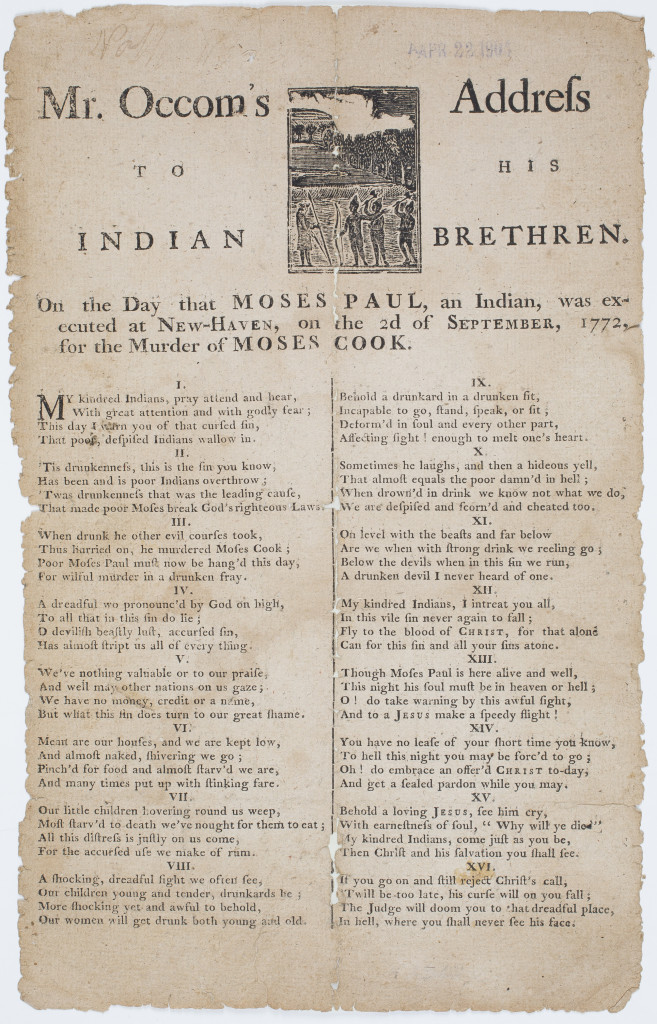 white students) instead. Occom then ministered to the Mohegan people in southern New England. In 1770, he would have been one of the most famous Native American men in the northeast.
white students) instead. Occom then ministered to the Mohegan people in southern New England. In 1770, he would have been one of the most famous Native American men in the northeast.
The “first” publication that made Occom famous is known as the “Sermon at the Execution of Moses Paul.” Occom’s sermon was published soon after Paul’s execution, in both pamphlet form and as a verse broadside, and then reprinted in numerous editions well into the nineteenth century. The title page of most editions of the sermon read “A sermon, preached at the execution of Moses Paul, an Indian, who was executed at New-Haven, on the 2d of Sept. 1772. For the murder of Mr. Moses Cook, late of Waterbury, on the seventh of December, 1771. Preached at the desire of said Paul.” It is this final sentence—“Preached at the desire of said Paul”—that is of most interest here.
As the title of the pamphlet states, Moses Paul (Wampanoag) killed a white man, Moses Cook, after a fight in David Clark’s tavern in Bethany, Connecticut, on December 7, 1771. Cook had beaten Paul after Paul objected when the proprietor of the tavern refused to serve him liquor. Moses Paul was tried in New Haven, convicted of murder, and sentenced to hang. As was the custom in early New England, a sermon intended to encourage the community to reflect on the solemnity of the occasion was preached before the execution. Paul’s first execution sermon was delivered by Jonathan Edwards, Jr.—a scholar of Native languages, and the son of the famous Puritan minister—on June 7, 1772, ten days before the date that was originally scheduled for Paul’s execution. An appeal to the Connecticut General Assembly delayed Paul’s execution, which was rescheduled for September 2, 1772.
On July 16, 1772, Moses Paul wrote to Samson Occom, “considering that we are of the same nation,” with the “earnest & dying request … that you would preach a sermon to me at my execution.” Occom would doubtless have been aware of Paul’s trial and impending death, and he accepted the invitation, delivering the sermon that would make Occom one of the most widely reprinted American authors of the 1770s. (The full text of the sermon is available via the Evans Text Creation Partnership here.)
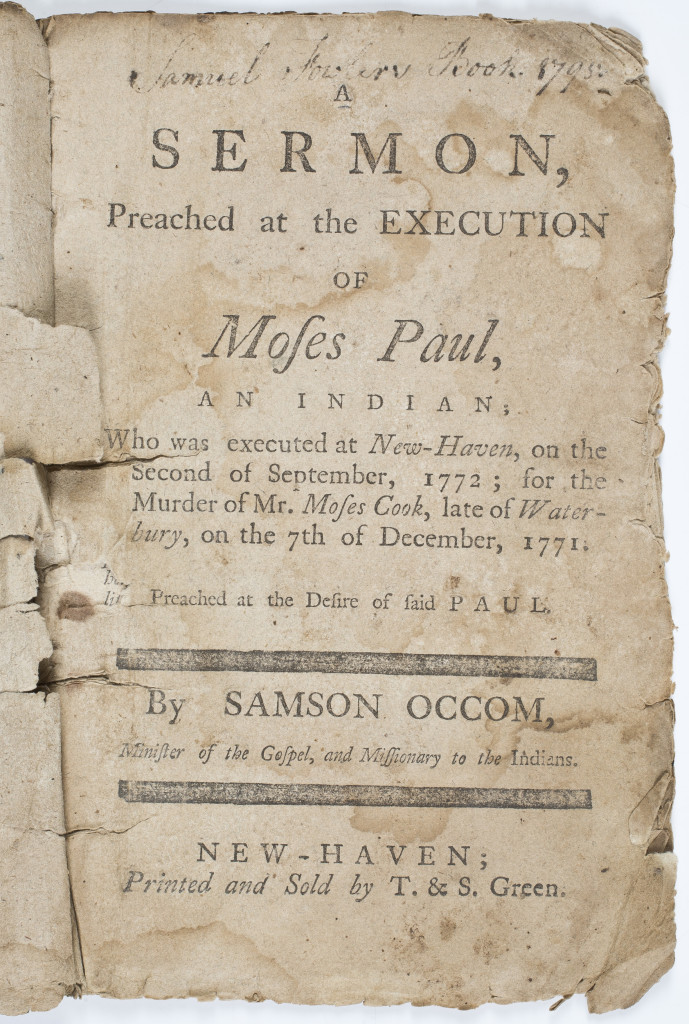 Scholars have long known that Paul specifically asked Occom come to New Haven to preach his execution sermon–the title page of the published version of the sermon tells us so (see left). In an 1899 biography of Occom, William DeLoss Love wrote that Paul “naturally turned to the man of his own race upon whom the Indians generally had come to look as their friend in trouble,” but offered no details (170). A 1935 biography by Harold Blodgett, however, offered a full transcription of Paul’s letter to Occom making the request, adding: “It is printed by courtesy of the American Antiquarian Society, which possesses the original.”
Scholars have long known that Paul specifically asked Occom come to New Haven to preach his execution sermon–the title page of the published version of the sermon tells us so (see left). In an 1899 biography of Occom, William DeLoss Love wrote that Paul “naturally turned to the man of his own race upon whom the Indians generally had come to look as their friend in trouble,” but offered no details (170). A 1935 biography by Harold Blodgett, however, offered a full transcription of Paul’s letter to Occom making the request, adding: “It is printed by courtesy of the American Antiquarian Society, which possesses the original.”
Which is true. This incredibly significant letter has been in the Society’s collections since 1931. A note in the “Miscellaneous Manuscripts P” folder, written by R.W.G. Vail, then the Society’s librarian, indicates that the letter to Occom came from “Mr. Edward F. Coffin, of Worcester, Feb. 19, 1931.” Yet, in the decades between the time that Blodgett transcribed the letter and today, the letter disappeared from AAS’s institutional memory (but not from our shelves). Almost all scholars who have written about Occom since the 1930s have relied on Blodgett’s faithful transcription of the letter instead of visiting Worcester to see the original. And since the letter is the only manuscript item in our holdings written by Moses Paul, it was never classified as its own collection, and thus was not included in our manuscript finding aids (our checklist of “miscellaneous manuscripts” was written by hand, and is only available in a binder in the reading room).
Mike Kelly, the head of archives and special collections at Amherst College, is at work on a bibliography of Occom’s execution sermon (he has thus far identified 23 distinct editions of the sermon from 1772 to 1829, 14 of which are held at AAS). He saw a reference to the letter in a 2004 article on Paul’s trial in the New England Quarterly by Ava Chamberlain (who did visit Worcester to see the original), and wrote to ask if we actually did have the letter. We looked in the Miscellaneous Manuscripts P folder, and it was exactly where it was supposed to be. But the question remained: how did it get there?
Edward Francis Coffin was born in New Hampshire in 1873. His father, E. W. Coffin, relocated the family to Worcester, where he ran a business selling store fixtures. Edward followed his
father into the family  business; the 1910, 1920, and 1930 U.S. Censuses all list his occupation as “store fixtures,” either as a salesman or proprietor.
business; the 1910, 1920, and 1930 U.S. Censuses all list his occupation as “store fixtures,” either as a salesman or proprietor.
But his heart was clearly not with display cases and cash registers, as he embarked on a side career as a collector of and dealer in Americana—a field to which Coffin was sufficiently dedicated to have had separate letterhead made. AAS has only one box of correspondence from Edward Coffin in our manuscript collection, covering the years 1912 to 1915. A note in the file from AAS librarian Clarence Brigham indicates that Coffin retired from business in 1939, 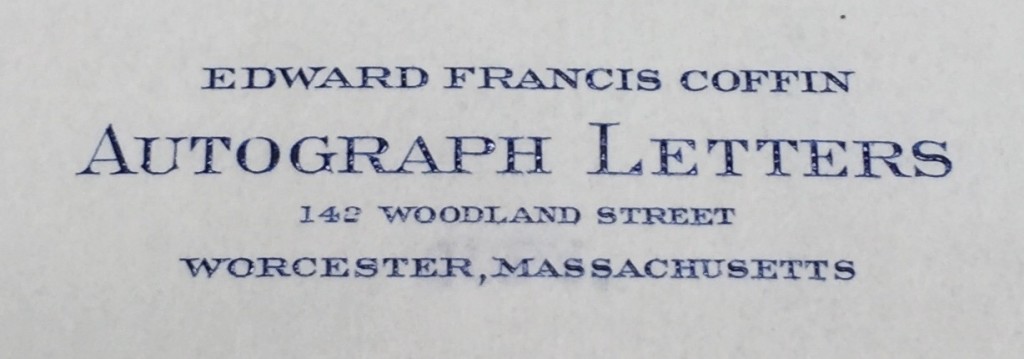 and continued dealing books and prints until his death in 1949. The note also states “Most of his correspondence was destroyed by him at his office, but this 1912-15 file happened to be saved at his home, and was sent to the Society by his son.”
and continued dealing books and prints until his death in 1949. The note also states “Most of his correspondence was destroyed by him at his office, but this 1912-15 file happened to be saved at his home, and was sent to the Society by his son.”
The letters in the collection at AAS are from fairly early in Coffin’s career as a collector and dealer, and at times do not reflect a terribly high level of sophistication. A series of letters between Coffin and a lawyer in Richmond, Missouri, inquiring about the descendants of a local family goes through several rounds before Coffin reveals the purpose behind the correspondence: he was inquiring (on behalf of a customer) if it would be possible to purchase the manuscript of the Book of Mormon, which he had heard had been handed down through the Whitmer family. His correspondent quite politely replied, “This manuscript can not be procured for love nor money as it is the rock upon which the church is founded….”
Several months later, Coffin wrote to the Supreme Court Justice Oliver Wendell Holmes Jr., asking the jurist to provide details about the date and origin of an ivory miniature of his father that Coffin had recently acquired. There is no evidence that Justice Holmes took the time to reply to the inquisitive store fixture salesman from Worcester.
In an April 30, 1914, letter to a book dealer in England, Coffin described himself thus: “I would say that I am a dealer in a general line of early American items, my chief line being material of an autographic character…. I also do something with early paintings, including miniatures, engravings of places, and especially Revolutionary subjects.” Clifford Shipton’s remarks in the AAS Proceedings in 1949 on Coffin’s passing note that he was “well versed in the field of early American art, and wrote occasional valuable monographs on historical subjects, such as the early maps of Worcester, the beginnings of photography in Worcester, and the contributions of Mary Baker Eddy to newspapers and magazines.” The extant materials paint a picture of a dedicated collector of specific genres of items who could be quite dogged in pursuing potential customers (his repeated efforts to find a buyer for a daguerreotype of Stephen A. Douglas were notably fruitless).
Letters in the AAS archives from the 1930s show that Coffin was still carrying on a fairly miscellaneous trade, offering for sale to the AAS items ranging from children’s books and juvenile magazines to a second edition of the Federalist to early American editions of Hoyle. He clearly did occasionally come into possession of some remarkable items. The AAS archives include an invoice from Coffin to the Society dated October 5, 1938, for $600.00 (over $10,000 today) for the 1855 first edition of Walt Whitman’s Leaves of Grass, one of the treasures of our collection.
So the letter from Moses Paul to Samson Occom does not seem to fit with the rest of Coffin’s interests. It is not autographed by a well-known figure, it does not concern Worcester history or the Revolution, nor does it involve the graphic arts. Where did he get the letter? Where was it between 1771 and the early twentieth century? Did Coffin try to sell the letter before placing it at AAS? If so, to whom? Given that he destroyed his correspondence, we may never know the answers to these questions. But we are delighted to have (re)-encountered this letter.
Further Reading
William DeLoss Love published the first full-length biography of Samson Occom, Samson Occom and the Christian Indians of New England (Boston: Pilgrim Press, 1899). The first full transcription of Moses Paul’s letter to Occom appeared in Harold Blodgett, Samson Occom (Hanover, N.H.: Dartmouth College Manuscript Series Number Three, 1935).
The most thorough account of Moses Paul’s trial is Ava Chamberlain, “The Execution of Moses Paul: A Story of Crime and Contact in Eighteenth-Century Connecticut,” New England Quarterly 77:3 (2004). Additional recent scholarship on Occom includes Joanna Brooks, American Lazarus: Religion and the Rise of African-American and Native American Literatures (New York: Oxford University Press, 2003); Brooks, ed., The Collected Writings of Samson Occom, Mohegan: Leadership and Literature in Eighteenth-century Native America (New York: Oxford University Press, 2006); and Phillip Round, Removable Type: Histories of the Book in Indian Country, 1663-1880 (Chapel Hill: University of North Carolina Press, 2010).

